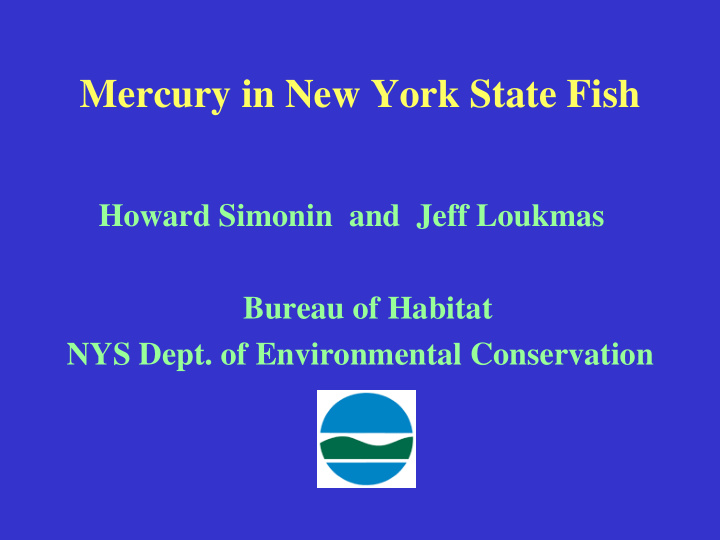



Mercury in New York State Fish Howard Simonin and Jeff Loukmas Bureau of Habitat NYS Dept. of Environmental Conservation
DEC Monitoring Efforts • Began monitoring Hg in fish before 1970 • Statewide Toxic Substances Monitoring Program (1976 – 1993) • Specific projects - higher Hg in acidic waters • Continuing targeted monitoring across NYS
Impacts on Fish and Wildlife • Fish - not able to excrete mercury; accumulates in muscle & fat - highest mercury in older piscivorous fish - possible reproductive impacts • Loons • Mink & Otter
Methylmercury • Bioaccumulates up food chains • Concentrations less than 1 ppt in the water can lead to concentrations greater than 1 ppm in fish and loons
Factors Affecting Bioaccumulation Water Quality Variables -Methylation depends on presence of sulfur reducing bacteria, anaerobic conditions, acidic conditions, dissolved organic carbon Hydrologic Variables - Reservoir, percent wetlands, watershed size Biological Variables - Fish species and age - Length of food chain affects fish Hg conc - Productivity of lake affects fish Hg conc
Statewide Strategic Monitoring Statewide Strategic Monitoring of Mercury in Fish of Mercury in Fish • 4 4- -year project: 2003 year project: 2003- -2006 2006 • • 131 lakes surveyed 131 lakes surveyed • • 4 target species 4 target species • – YP, LMB, SMB, WEYE YP, LMB, SMB, WEYE – • Primarily new lakes, Primarily new lakes, • temporal and spatial temporal and spatial trends, test model trends, test model • Summarize historical Summarize historical • database database
2001-2005 study lakes (N=148)
Walleye (271) Smallmouth Bass (553) Chain Pickerel (69) Northern Pike (15) Largemouth Bass (499) White Perch (107) Brown Trout (69) Yellow Perch (994) Common Carp (88) Black Crappie (53) 0 0.2 0.4 0.6 0.8 1 1.2 1.4 Total Mercury (ppm)
Standard size determinations 1.6 Chodikee Lake Largemouth Bass 1.4 1.2 Mercury (ppm) 1 0.70 0.8 0.6 0.4 Hg conc. = - -1.6213+ (0.00604 x Length) 1.6213+ (0.00604 x Length) Hg conc. = 0.2 0 300 320 340 360 380 400 420 440 460 480 500 Length (mm)
9 inch Yellow Perch Mean = 0.35 ppm # Lakes = 95 0.30 – 0.99 ppm: <0.30 ppm: >1.00 ppm:
Standard Size Smallmouth Bass Hg Conc. vs. pH
Have mercury levels changed? Have mercury levels changed? • Selected 20 lakes with data Selected 20 lakes with data • from 10 – – 20 years ago 20 years ago from 10 • Mostly YP from Adirondack Mostly YP from Adirondack • Lakes Lakes • Repeated the historical Repeated the historical • sampling effort to determine sampling effort to determine trends trends
Trend analysis – – Cranberry Lake Cranberry Lake Trend analysis Smallmouth Bass Bass Smallmouth P- -values values P Slopes - - 0.2484 Slopes 0.2484 Elevations - - 0.0014 Elevations 0.0014 ANCOVA: P = 0.02
Change in Mercury Concentration Lake Size/Species Change Lake Size/Species Change • Lake Adirondack Lake Adirondack 9 inch YP 9 inch YP + 0.08 ppm ppm • + 0.08 • Cranberry Lake Cranberry Lake 15 in. SMB - 0.48 0.48 ppm ppm • 15 in. SMB - • Ferris Lake Ferris Lake 9 in.YP - 0.67 0.67 ppm ppm • 9 in.YP - • Big Moose Big Moose 9 in.YP - 0.20 0.20 ppm ppm • 9 in.YP - • Kings Flow Kings Flow 9 in. YP - 0.22 0.22 ppm ppm • 9 in. YP -
Policy Implications Policy Implications Health Advisories Health Advisories • Prior to these studies Prior to these studies • there were 24 lakes with there were 24 lakes with mercury advisories mercury advisories • Based on review of data Based on review of data • from 17 NYC reservoirs from 17 NYC reservoirs and 96 statewide lakes and 96 statewide lakes (2001 – – 2004), DOH 2004), DOH (2001 issued 49 additional issued 49 additional advisories advisories
Adirondacks and Catskills Adirondacks and Catskills • High rates of deposition • Acid conditions are likely contributing to higher Hg concentrations • In 2005 DOH issued region-based advisory for Parks
Yellow Perch 9 inch YP Out of Parks: 0.18 ppm Inside Parks: 0.54 ppm Smallmouth Bass 15 inch SMB Out of Parks: 0.51 ppm Inside Parks: 1.05 ppm
All inland lakes tested 1970 – 2004 73 Lakes with Health Advisories:
What’s next? • Analyze ~600 additional fish from 25 lakes • Test simple predictive model • Examine landscape characteristics that may influence mercury accumulation • Examine mercury in other biota (e.g., macroinvertebrates, songbirds, loons, etc.)
Recommend
More recommend